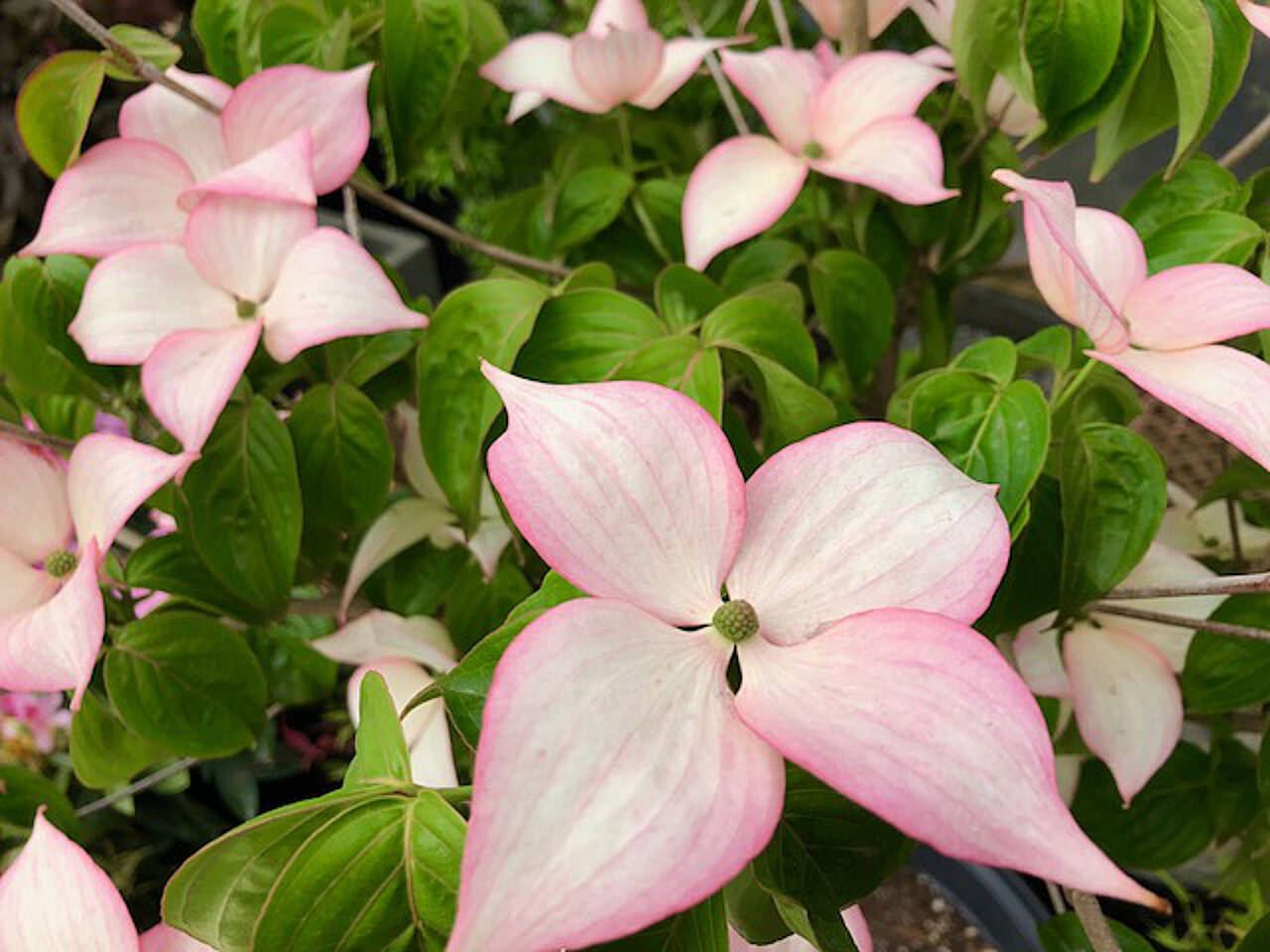The genus Cornus (the Latin name we assign to Dogwoods), is comprised of many different species that are common to Northwest gardens.
Starting in late March, our native dogwood tree, Cornus nutallii, starts blooming. It’s an upright tree that can reach 40 feet tall and sports extremely large white flowers. Unfortunately, it is very disease-prone and rarely found in the trade any more.
Then in May, we can observe the Eastern dogwood, Cornus florida, a smaller tree with horizontal branching that comes in both white and pink flowering forms.
Finally, in the month of June, the Korean dogwoods, Cornus kousa, come into bloom. They are a slightly larger tree with more of a rounded form and can also bloom in either white or shades of pink, like the eastern varieties.
In addition to these three tree species, there are also many forms of twig dogwoods — an easy-to-grow shrub noted for its striking bright red, orange, or yellow twigs in the winter. There is even a sweet little ground cover form called Cornus canadensis, or Bunchberry that can be found in our native woods and is sold as a low growing perennial for the shade.
But mostly, it is Cornus kousa and its several hybrids that I would like to spend time on this week.
Korean dogwoods have a lot going for them. In addition to beautiful flowers, they have a charming red berry-like fruit that dangles on the limbs in late summer (and is actually edible). They are also much more resistant to dogwood anthracnose, which is why most nurseries now recommend planting Korean dogwoods over all other varieties. There are several choices of the straight species, including the following:
Chinensis: Sometimes referred to as a Chinese dogwood, white flowers and fruit are slightly larger than the species.
Milky Way: Another selection of the chinensis cultivar, Milky Way is absolutely smothered with white flowers in spring.
Greensleeves: Extremely dark glossy green foliage is a fantastic backdrop to the excessively abundant white flowers.
Snow Tower: The growth habit of this selection is tall and narrow, reaching maybe 15 to 20 feet tall and only 5 to 8 feet wide, making it an excellent choice for a narrow spot in the garden. Naturally, it is covered with white flowers, hence the name Snow Tower.
Satomi: Probably the best pink flowering variety of the species. It has been around for a long time, so it is tried and true.
Heart Throb: A good pink flowering selection of the species with bigger flowers than Satomi
Now, here is where it gets interesting. About 30 years ago, a professor from Rutgers University by the name of Dr. Elwin Orton started a program of breeding to “save” the North American dogwoods that were being killed by insects and diseases. He crossed the eastern dogwood with the Korean dogwood (which is more disease resistant). His new hybrids reached the market in the early 1990s under the name of the Stellar Series. They were all the rage and I remember selling lots of these improved selections to gardeners all over the Puget Sound region.
While the Stellar Series was big hit, Orton continued his breeding program and began crossing the Korean variety with our Northwest native variety. This is when he really found some success. Starting in 2004, these new hybrids we released with the vigor and larger flowers of our native dogwood and the insect and disease resistance of the Korean species. Here are some of the choices on the market now:
Venus: This is a vigorous tree reaching 25 by 25 in 10 years with creamy white flowers that can exceed 6 inches across.
Starlight: Similar to Venus only blooms about one week earlier and the flowers are slightly smaller and have a greenish tone.
Rosy Teacups: Three-inch flowers on this gem are shades of medium to light pink with deeper colors toward the edges. While the flowers are smaller than Venus, there are lots of them and can last about 3 weeks or more depending on weather.
Scarlet Fire: This variety is the result of open pollination and the university is in the process of determining the parentage. That being said, it is a gorgeous tree with dark deep pink to fuchsia flowers that literally glow from a distance.
All dogwoods need good drainage and full to partial sun to thrive. Once they are established, they can be fairly drought resistant. Newly purchased plants often take a few years to come into their own, so don’t be discouraged if your flowers are a bit underwhelming the first couple of seasons. Keep them well watered and fed and they should reward you eventually.
Needless to say, now is the time of observe dogwoods at your favorite garden center. And don’t forget, their bark is worse than their bite! Stay safe and keep on gardening.
Steve Smith represents Sunnyside Nursery in Marysville, and can be reached at sunnysidenursery@msn.com
Free class
Sunnyside’s next free online class will be “Pruning In Summer” at 10 a.m. June 18. For more information, go to www.sunnysidenursery.net/classes.
Talk to us
> Give us your news tips.
> Send us a letter to the editor.
> More Herald contact information.

























